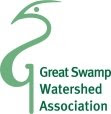
The Great Swamp is home to 32 species of mammals, 21 species of reptiles and 18 species of amphibians -- but all these creatures are dominated by a particular creature category called homo sapiens, or more commonly, humans! Has this been a happy relationship?
How Did It Start?
When European settlers arrived in the Great Swamp area, they found evidence of at least two permanent Lenni Lenape Native American communities. Since then a number of Native American camp sites have been identified near the Great Swamp. Agricultural products, animal skins, herbs for medicinal purposes, and trees for canoe transportation, were obtained from the Swamp by these early inhabitants.
During the first part of the 17th century, the Native Americans were left alone in the area. The Minisink Trail, a significant “Indian trail” in the area, used extensively by the Lenni Lenape, crossed the Swamp’s neighboring town of Chatham.
A Second Wave
By 1664, the territory that would become New Jersey was divided into East Jersey and West Jersey. Certain land in and around the Great Swamp area was acquired at one point by Sir William Penn and his sons. However, it appears that “clear” title passed in 1708 to another group of English investors who purchased the land that included the Great Swamp. It is reported that the Native Americans thought they were granting hunting and fishing rights, but English law was applied, and they lost their land.
By the early 18th century, farms and mills provided the principal occupations, as towns developed around the Swamp, but the population remained light. A devastating fire in the Great Swamp in 1782 following a period of drought, burned for weeks, to the detriment of those dependent upon the Swamp’s resources.
Trades and Professions Replace Farming
Efforts to farm the land in the 19th century were difficult, and despite efforts to drain the area, it remained primarily wetlands and wilderness However, newly established railroad lines from New York City by the end of the 19th century, changed the character of the communities around the area. Residential and professional pursuits began to replace farming, but some of the “small town” feeling remained. When plans for a jetport in the Great Swamp were revealed in 1959, the depth of feeling to preserve this place became apparent and the jetport plan was defeated.
Reportedly, some 250,000 people visit the Great Swamp each year. Residents and visitors continue to hold great power to do good as well as harm in the Great Swamp. Fortunately, the choice made by most affected homo sapiens has been to protect and preserve the Great Swamp. We hope to continue in this direction.
The Great Swamp Watershed Association with some 1600 members and a variety of continuing conservation projects, is one example of how the “largest Great Swamp creature” is benevolent, protecting the natural environment for future “creatures” of the Great Swamp.
How Did It Start?
When European settlers arrived in the Great Swamp area, they found evidence of at least two permanent Lenni Lenape Native American communities. Since then a number of Native American camp sites have been identified near the Great Swamp. Agricultural products, animal skins, herbs for medicinal purposes, and trees for canoe transportation, were obtained from the Swamp by these early inhabitants.
During the first part of the 17th century, the Native Americans were left alone in the area. The Minisink Trail, a significant “Indian trail” in the area, used extensively by the Lenni Lenape, crossed the Swamp’s neighboring town of Chatham.
A Second Wave
By 1664, the territory that would become New Jersey was divided into East Jersey and West Jersey. Certain land in and around the Great Swamp area was acquired at one point by Sir William Penn and his sons. However, it appears that “clear” title passed in 1708 to another group of English investors who purchased the land that included the Great Swamp. It is reported that the Native Americans thought they were granting hunting and fishing rights, but English law was applied, and they lost their land.
By the early 18th century, farms and mills provided the principal occupations, as towns developed around the Swamp, but the population remained light. A devastating fire in the Great Swamp in 1782 following a period of drought, burned for weeks, to the detriment of those dependent upon the Swamp’s resources.
Trades and Professions Replace Farming
Efforts to farm the land in the 19th century were difficult, and despite efforts to drain the area, it remained primarily wetlands and wilderness However, newly established railroad lines from New York City by the end of the 19th century, changed the character of the communities around the area. Residential and professional pursuits began to replace farming, but some of the “small town” feeling remained. When plans for a jetport in the Great Swamp were revealed in 1959, the depth of feeling to preserve this place became apparent and the jetport plan was defeated.
Reportedly, some 250,000 people visit the Great Swamp each year. Residents and visitors continue to hold great power to do good as well as harm in the Great Swamp. Fortunately, the choice made by most affected homo sapiens has been to protect and preserve the Great Swamp. We hope to continue in this direction.
The Great Swamp Watershed Association with some 1600 members and a variety of continuing conservation projects, is one example of how the “largest Great Swamp creature” is benevolent, protecting the natural environment for future “creatures” of the Great Swamp.


No comments:
Post a Comment